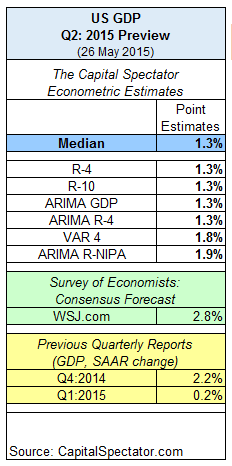The US economy is widely expected to grow at a faster rate in the second quarter vs. Q1, but that may turn out to be a hollow achievement. Indeed, the hurdle is quite low for beating the near-flat expansion in the first three months of the year vs. 2014’s Q4. As for the outlook for this year’s Q2 data, which the government will publish on July 30, let’s just say that minds (and models) differ by more than a trivial degree at this point.
You can drive a truck through the gap that separates the relatively bullish second-quarter GDP forecasts from the projections on the low end. Midway among the extremes is The Capital Spectator’s median Q2 estimate: an increase of 1.3% (real seasonally adjusted annual rate), which is based on a several econometric projections. The median forecast, although sluggish by historical standards, represents a substantial improvement over Q1’s tepid 0.2% increase, as reported by the Bureau of Economic Analysis (BEA) last month.
As for looking ahead, The Wall Street Journal’s current survey anticipates a relatively strong rebound in Q2 GDP’s growth: 2.8%, based on the average prediction via a polling of dismal scientists in May. Meantime, no one will confuse the Journal’s forecast with the Atlanta Fed’s latest nowcast (as of May 19) for a thin 0.7% gain, which is dangerously close to Q1’s disappointing stall-speed rise.
But if there’s trouble brewing, you wouldn’t know it by listening to Fed Chair Janet Yellen, who dispatched a relatively upbeat forecast last week. “If the economy continues to improve as I expect, I think it will be appropriate at some point this year to take the initial step to raise the federal funds rate target,” she said in a speech on Friday.
Her outlook is either prescient or hopelessly naïve, depending on the forecast you choose for guidance. Then again, it’s still early and most of Q2’s economic numbers are still ahead of us, which means that expectations could change dramatically in the weeks ahead as new data arrives. Meantime, the current lineup of predictions are dispatched far and wide. Here’s a graphical summary of how The Capital Spectator’s Q2:2015 estimate compares with recent history and forecasts from various sources:

Here are the various forecasts that are used to calculate Capital Spectator.com’s median estimate:

As updated estimates are published, based on incoming economic data, the chart below tracks the changes in the evolution of The Capital Spectator’s projections.

Finally, here’s a brief profile for each of The Capital Spectator’s GDP forecast methodologies:
R-4: This estimate is based on a multiple regression in R of historical GDP data vs. quarterly changes for four key economic indicators: real personal consumption expenditures (or real retail sales for the current month until the PCE report is published), real personal income less government transfers, industrial production, and private non-farm payrolls. The model estimates the statistical relationships from the early 1970s to the present. The estimates are revised as new data is published.
R-10: This model also uses a multiple regression framework based on numbers dating to the early 1970s and updates the estimates as new data arrives. The methodology is identical to the 4-factor model above, except that R-10 uses additional factors—10 in all—to forecast GDP. In addition to the data quartet in the 4-factor model, the 10-factor forecast also incorporates the following six series: ISM Manufacturing PMI Composite Index, housing starts, initial jobless claims, the stock market (Wilshire 5000), crude oil prices (spot price for West Texas Intermediate), and the Treasury yield curve spread (10-year Note less 3-month T-bill).
ARIMA GDP: The econometric engine for this forecast is known as an autoregressive integrated moving average. This ARIMA model uses GDP’s history, dating from the early 1970s to the present, for anticipating the target quarter’s change. As the historical GDP data is revised, so too is the forecast, which is calculated in R via the “forecast” package, which optimizes the parameters based on the data set’s historical record.
ARIMA R-4: This model combines ARIMA estimates with regression analysis to project GDP data. The ARIMA R-4 model analyzes four historical data sets: real personal consumption expenditures, real personal income less government transfers, industrial production, and private non-farm payrolls. This model uses the historical relationships between those indicators and GDP for projections by filling in the missing data points in the current quarter with ARIMA estimates. As the indicators are updated, actual data replaces the ARIMA estimates and the forecast is recalculated.
VAR 4: This vector autoregression model uses four data series in search of interdependent relationships for estimating GDP. The historical data sets in the R-4 and ARIMA R-4 models noted above are also used in VAR-4, albeit with a different econometric engine. As new data is published, so too is the VAR-4 forecast. The data sets range from the early 1970s to the present, using the “vars” package in R to crunch the numbers.
ARIMA R-NIPA: The model uses an autoregressive integrated moving average to estimate future values of GDP based on the datasets of four primary categories of the national income and product accounts (NIPA): personal consumption expenditures, gross private domestic investment, net exports of goods and services, and government consumption expenditures and gross investment. The model uses historical data from the early 1970s to the present for anticipating the target quarter’s change. As the historical numbers are revised, so too is the estimate, which is calculated in R via the “forecast” package, which optimizes the parameters based on the data set’s historical record.
